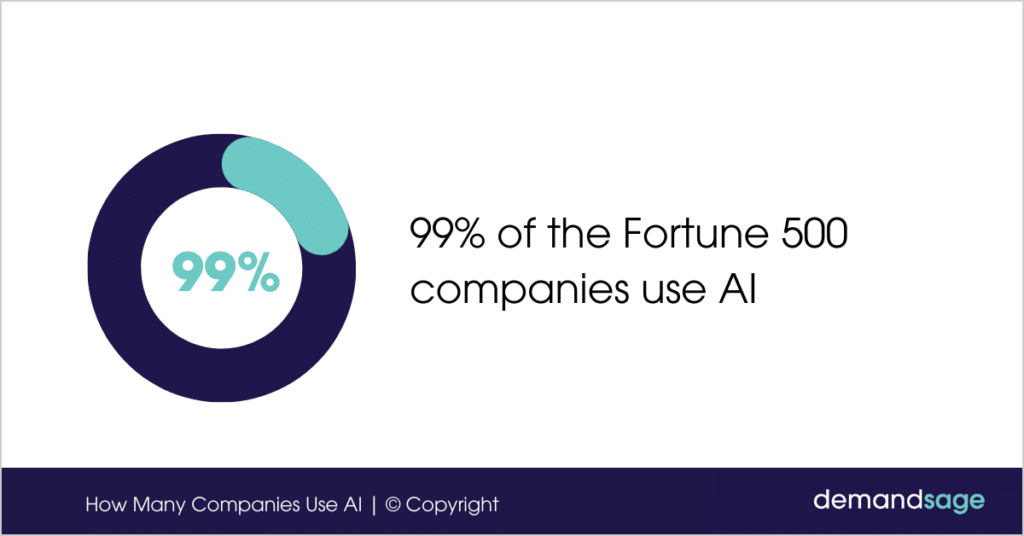In today’s data-driven economy, artificial intelligence is the secret weapon powering some of the world’s most successful companies. From personalized customer experiences to predictive forecasting and intelligent automation, Fortune 500 enterprises are leading the AI charge, using technology to streamline operations, increase agility, and maintain a competitive edge.
In this comprehensive spotlight, we explore how Fortune 500s are using AI to stay ahead, with real examples, strategic insights, and future trends shaping enterprise success in 2025.
Introduction to Enterprise AI Leadership
The world’s largest companies are not just adopting AI—they’re engineering their business models around it. In sectors like finance, healthcare, retail, and logistics, AI has moved beyond innovation departments into the core of business operations.
By leveraging AI for speed, intelligence, and scale, Fortune 500s are redefining what it means to lead in the modern economy.
Core Benefits of AI Adoption in Large Enterprises
- ✅ Cost Optimization – Reduced manual labor and overhead
- ⚡ Operational Speed – Real-time data analysis and action
- 🤝 Personalized Engagement – Tailored experiences at every touchpoint
- 📈 Strategic Insights – Predictive analytics for smarter decisions
- 🔄 Automation at Scale – AI supports workflows from IT to HR
AI in Fortune 500 Business Models
🔍 AI-Augmented Enterprises:
Use AI to enhance existing processes, support employees, and improve efficiency (e.g., Walmart using AI for supply chain visibility).
🤖 AI-First Enterprises:
Build entire business models on AI capabilities, like Amazon’s recommendation engine or JPMorgan’s AI in fraud detection.
In both models, AI is not an “add-on”—it’s a business differentiator.
Use Case 1: Predictive Analytics for Market Shifts
Fortune 500s are turning to AI-powered predictive analytics to forecast:
- Sales trends
- Consumer demand
- Financial performance
- Global economic changes
Example:
PepsiCo uses AI to analyze weather, social media, and sales data to forecast demand and optimize regional inventory.
Use Case 2: Hyper-Personalization in Customer Experience
AI allows brands to deliver tailored recommendations, pricing, and messaging across web, mobile, and in-store channels.
Example:
Bank of America’s virtual assistant Erica uses machine learning to deliver financial insights based on user behavior.
Sectors impacted:
- Retail (product suggestions)
- Healthcare (personalized treatment)
- Banking (custom offers and risk scoring)
Use Case 3: Intelligent Automation of Back-Office Operations
From invoice processing to HR onboarding, AI is powering robotic process automation (RPA) across departments.
Example:
Pfizer uses RPA bots to automate regulatory filing and internal approvals, cutting down manual workload by 60%.
Use Case 4: AI in Product Innovation
AI is fueling the next wave of enterprise innovation:
- Digital twins for product testing
- Generative design and simulation
- Voice-of-customer trend analysis
Example:
Nike uses AI to track fashion trends and design shoes that respond to real-time consumer preferences.
Use Case 5: Risk Management and Compliance with AI
AI is crucial for identifying and mitigating risk in financial services, legal compliance, and internal audit.
Example:
JPMorgan Chase uses AI to scan regulatory documents and contracts, saving 360,000 hours annually.
Top Fortune 500s Leading with AI
| Company | AI Focus Area |
|---|---|
| Amazon | Personalization, logistics, Alexa AI |
| JPMorgan Chase | Fraud detection, contract analysis |
| Walmart | Inventory automation, customer analytics |
| Pfizer | Drug discovery, regulatory automation |
| PepsiCo | Demand forecasting, smart manufacturing |
These leaders are embedding AI into every layer of their business.
Key Tools Powering Fortune 500 AI Transformation
| Tool/Platform | Functionality |
|---|---|
| AWS SageMaker | End-to-end machine learning model deployment |
| Azure OpenAI Service | GPT integration into enterprise apps |
| Salesforce Einstein | AI for CRM, marketing, and sales operations |
| Google Vertex AI | Custom model training, AutoML, and explainability |
| DataRobot | Predictive analytics and AutoML |
Internal AI Teams vs External Partnerships
Fortune 500s scale AI through:
- 💡 Internal AI Labs: e.g., Walmart’s Intelligent Retail Lab
- 🤝 Startup Collaborations: e.g., Pfizer’s partnerships with AI drug discovery firms
- 🧠 Consulting Firms: Deloitte, Accenture, and PwC offer custom enterprise AI solutions
Build vs Buy Strategy:
Most companies combine in-house talent with external partnerships to accelerate time-to-value.
Metrics Used by Fortune 500s to Measure AI ROI
| Metric | Why It Matters |
|---|---|
| Efficiency Gains | Cost or time saved through automation |
| Revenue per Employee | Scalable growth with leaner teams |
| Customer Retention & NPS | AI’s impact on user experience |
| Forecast Accuracy | Better planning through predictive insights |
| Risk Reduction Rate | Measurable drop in compliance failures |
AI Governance in Fortune 500 Companies
With great power comes great responsibility. Enterprises enforce:
- ✅ Ethics Boards & AI Committees
- 🧪 Bias Testing and Fairness Audits
- 📋 Transparent Documentation
- 🔐 Data Privacy Controls (GDPR, CCPA, etc.)
Example:
IBM’s AI Ethics Board ensures every AI project aligns with internal and societal standards.
Future Trends in Enterprise AI (2025–2030)
🔮 Autonomous Decision Systems – AI making real-time calls in logistics and finance
🤖 Cognitive Agents – AI copilots in HR, legal, and marketing workflows
🎯 Multi-modal Models – Combining voice, text, and visual inputs for more accurate decision-making
🌐 AI-Driven Sustainability – Monitoring carbon, water, and supply chain impact with real-time AI
Conclusion
AI is not just a tool—it’s a strategic pillar for enterprise growth. As Fortune 500s continue to innovate with AI, they prove that responsible, scalable, and customer-centric AI adoption is not only possible but essential.
If your business aims to lead the market, now’s the time to invest in enterprise-grade AI infrastructure, governance, and culture. The companies that stay ahead are those that act now—and act smart.


